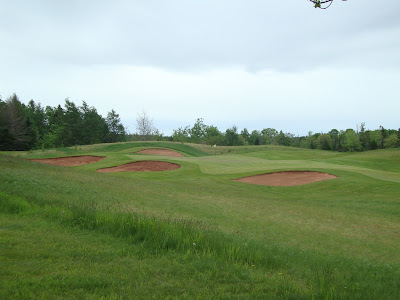I've recently returned from a quick trip to West Virginia, Kentucky and Indiana. In my 3 full days there I did a loop starting/finishing in Cincinnati, in which I played the Pete Dye GC, the Old White TPC at The Greenbrier, Valhalla and Victoria National. It was a very busy couple of days (particularly the first day, when I played an early round at Pete Dye GC, drove 3 hours to Old White for an afternoon tee off, and later drove into the night to arrive in Lexington)!
This, along with trips to Scottsdale in January and LA/Palm Springs in February, has pointed out a huge flaw in my blogging: the heading "Playing
Canada's Top 100 Golf Courses". When I started this blog a few years ago I was still quite early in my university career, and was very limited with travel. Consequently, the realm of possibility seemed quite narrow in the immediate future. I thought Canada's top 100 courses was an achievable goal, and set my sights on this near-sighted target.
I am still placing a large emphasis on the Canadian top 100 (for the purposes of this blog), but will be broadening this emphasis as I catch up on course write-ups. This seems only fair, as I have been making 2-3 golf trips in the USA for every trip I take in Canada. The posts in this blog don't reflect all of my recent travels, but I will keep with the current format for the time being so I can find a proper way to document my American adventures! For now, I will just provide a brief write-up on this last trip of mine, in which I played the #1 private and public courses in West Virginia, along with the #1 private courses in Kentucky and Indiana.
PETE DYE GC
 |
| Front entrance of the Pete Dye Golf Club. Bridgeport, WV |
As the front entrance indicates, the Pete Dye GC is built on an old mine, and the course is covered with remnants of the old mine. Train cars, tee markers made of the old tracks, and even open mine shafts provide a reminder of the properties previous occupants.
 |
| Some of my favorite tee markers...very fitting! |
In short, the Pete Dye GC is the best Dye course I have played at this point in my travels, rankings aside. There is a plaque at the bag drop that says "18 of the most exciting and memorable holes I have ever built on one course"-Dye, which gives you an indication of what is to come. My quick take is that holes 1-2, 7-17 are just that: some of Dye's most exciting and memorable. There truly are some stretches of world-class holes. I started on hole 10, but will start from #1 for ease of describing the course. #1 and #2 are good starting holes, the first being relatively gentle, and the second having more teeth. 3,4 and 6 were the most bland on the course, with the 5th being a very awkward and uninviting hole. This is certainly the worst stretch on the course. Hole 7 is where the fun really begins.
 |
| The beautiful downhill par 3 7th |
The downhill 7th, and roller-coaster ride par 5 8th are the most dramatic holes on the course among those without water in play. I thought 9 was a good strong par 4 which plays well as an 18th (as I played it). #10 is the most photographed hole, and rightly so!
 |
| Severely sloped par 4 10th |
The drive and approach are obviously quite intimidating, but much more forgiving than you might think. At around 300 yards, the 12th is one of my favorite holes on the course. The green is out of sight from the tee, but there is enough room around the green to allow an aggressive play from the tee. The fairway is wide and encourages a layup, but a huge bunker on the left side of the hole obstructs the view to the green from a poorly positioned tee shot. The hole is both beautiful, and strategically interesting!
 |
| From right of the fairway on the awesome short 12th |
While I really liked the 13th and 16th, and had no issue with 14 and 15, I'll skip ahead for now. The closing stretch is brutally difficult, but I really enjoyed 16 and 17, a long 3 and shorter 4. The challenge of 17 is the approach; the green is one of the toughest I've ever played. The green has a number of humps and ridges, and falls off on almost all sides. As I can attest to, the green is receptive and playable.. but I wouldn't want to put myself out of position!
 |
| The WILD 17th green |
The closing hole is really unfortunate. It is far too difficult, bordering on unfair. The hole demands a long, straight drive over water, which will leave a mid-length, blind approach to a narrow green with bunkers on both sides, and water close to the left edge of the green. The hole is gorgeous... but almost unplayable. It was my least favorite on an otherwise incredible course.
After finishing I grabbed a quick lunch and drove 3 hours south to The Greenbrier, where I had an afternoon tee time at the Old White TPC. My first Macdonald/Raynor course!
Old White TPC
Simly put, it was love at first sight.
Within 2 weeks of visiting, the course was flooded, causing a cancellation of the PGA Tour's upcoming Greenbrier Classic. Devastating! Fortunately I had ideal conditions, and an amazing experience!
The first 2 holes are refreshingly simple par 4s with nice green complexes, leading you to the biarritz 3rd. My first authentic biarritz! Laying eyes on the 3rd was one of my favorite golf experiences in recent memory, it is an absolute stunner!
 |
| Biarritz from the tee |
 |
| The biarritz from just off the back of the green looking back |
Having read plenty about Raynor's template holes, I knew exactly what to expect from this gem... but seeing this hole in person was so much better than anything you can read. The green is massively long, it really is like 2 full greens. I can forever say that I birdied my first biarritz with a strong back pin. What a day!
The approach to the 4th may be the most bland on the front side, but whatever it lacks, the approach to #5 makes up for. Huge cone-line mounds obstruct the view of the left side of the green, which is actually much larger than it appears.
 |
| The fascinating par 4 5th, one of my favorites |
#6 is the toughest hole on the course, while #7 is a birdie chance (a really aesthetically pleasing one at that!). The 8th was my first ever authentic Macdonald/Raynor redan, which also has mounds similar to the 5th.
 |
| Redan 8th |
So much has been said about the original redans, I don't know what more I can add. All I can say is that this is a really, really good redan.. and that the green was far deeper than I imagined it would be. It is a generous hole if you hit a solid shot. I absolutely loved it.
The punchbowl 9th and principal's nose 10th are some of the prettiest holes on a course full of gorgeous holes. Both are birdie chances, particularly the 9th. #11's main defense is length, and has softer bunkering than most holes on the course.
The 'long' par 5 12th is breathtaking, and strategically fantastic. The green can be reached in 2, but takes a perfect drive, and precise 200+ yard second shot. As a 3 shot hole, it is no bargain either. The cross-bunkers and creek demand a careful layup.
 |
| The second shot on the par 5 12th.. Go for it or lay back? |
The 'alps' 13th is a very beautiful hole, but I found that the mound fronting the right of the green was unnecessary, as the doglog right has heavy tree growth to the right. As such, it is almost impossible to hit a drive that will cause the small mountain to obstruct the view of the green. It is, nonetheless, a really cool hole.
A really beautiful 14th guides you to the 'eden' 15th. This rendition of the eden is extremely pretty, but I was slightly disappointed that the slope of the green wasn't greater. By no means a bad hole, however.
The 'cape' 16th wasn't a bad hole, but it may have been my least favorite on the back 9. In retrospect, I think this may have been because I found it difficult to identify a reference point/target line from the tee. In other words, I couldn't tell how aggressive I was actually playing. I feel like this takes away from the purpose (risk/reward) of a cape hole.
I loved #17, a long par 5. The classic design includes a series of cross bunkers which must be navigated on a lay-up. None of my pictures captured the feel you have standing there in person. It wasn't until I got up to the green that I realized the plateau-like drop off that lies beyond the green.
 |
| Back edge of the 17th green |
The slope is only about 2 ft high, but is steep enough to prevent a 'bump-and-run' into the hill, and likely deter the use of a putter. With a green running away, it is a really tough chip. I absolutely loved #17, tee to green.
As many know, the Old White TPC is one of few courses that ends on a par 3. I didn't get to play it from normal tees (due to tournament preparation), so I will not further comment. It is easy to find pictures of the green, which is the main defense, with a large slope bisecting the green.
Of the 4 courses I played on this quick trip, Old White certainly is not
the best course, but it very well could have been my favorite. It truly is a classic gem. Raynor's work (the amount of Macdonald's original design that still exists is up for debate) is just incredible. Without exaggeration, there are 9 signature holes. Of the remaining holes, I felt as though 6 were really good, and 3 were okay. If not for the hefty price tag, I would happily play here every day and never get tired of it... isn't that what actually makes a course great? I sure think so.
I intended on including all 4 of the courses from my trip in this post, but I have already written a lot more than I expected I would. Therefore, I am going to end here, and write a supplemental post for the other 2 courses I played: Valhalla and Victoria National. Stay posted for what's to come!
'Til next time, keep your stick on the ice!
The Golfing Canuck






















































